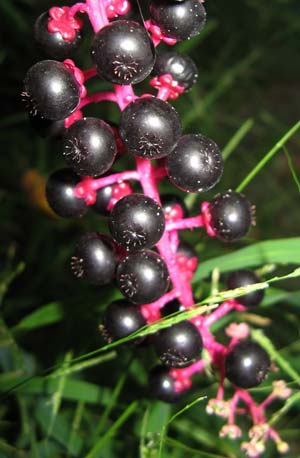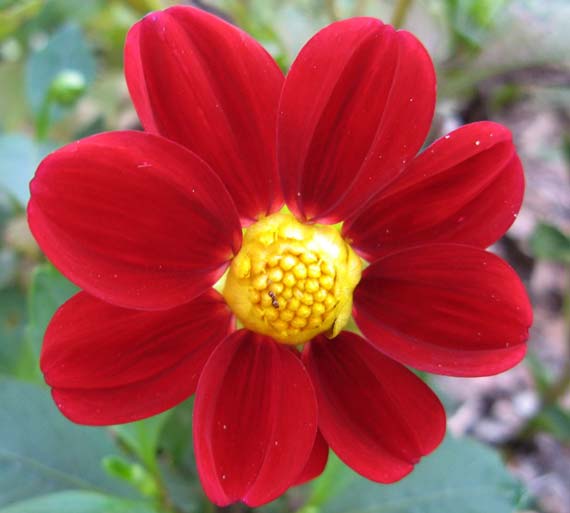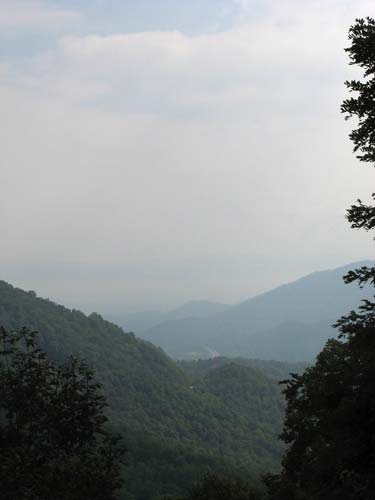Ohio? Really?
Saturday, 30 September 2006

Ohio. I think of, at this time of year, long miles of maize and soybean fields. It’s not all that, however; this lady resides in Cincinnati.
Saturday, 30 September 2006

Ohio. I think of, at this time of year, long miles of maize and soybean fields. It’s not all that, however; this lady resides in Cincinnati.
Friday, 29 September 2006

Remember those not-so-cute ducks from last spring? (This one’s for you, rmj.)
Several webbie pages of interest: jcb sent me a link to this page, on information aesthetics. Really. Information display to the max. And on that page, I found a link to this page, which has a nifty changing map of nations, states, and empires across the Middle East over the last 3K years. Makes me think my black-and-white Word tables are—well ,I admit it, I knew it already—borrrrrrrr-ing.
Thursday, 28 September 2006

Toxic. That’s what you should know about the otherwise rather attractive oleander (Nerium oleander). Florida’s campgrounds, where unwise landscapers often planted oleanders for their evergreen foliage and lovely blooms, are festooned (or at least they used to be; it’s been a while!) with signs advising unwary campers to under no conditions burn oleanders or use their twigs for marshmallow sticks. Unlike poison ivy, you won’t be bothered by touching oleander, just by contact with or ingesting its sap. Bonus tidbit: Azaleas and rhododendrons also have some toxicity.
Meanwhile, a new 527 organization has been formed to watchdog our government: Scientists and Engineers for America, with a thoughtful bill of rights.
If you want a real dose of feel-good, read this on neuroscientist Paul Greengard, who has taken his 2000 Nobel Prize money and established the annual $50,000 Pearl Meister Greengard Prize to bring more attention to outstanding research in biomedicine by women.
Wednesday, 27 September 2006

Autumn’s scepter has endowed a tiny minority of the foliage with new colors, bringing this sweet gum’s (Liquidambar styraciflua) star-shaped leaf to new heights of artistry.
Or something.
Tuesday, 26 September 2006

I remember always hearing about the tomato juice bath for removing skunk stench, although no one said it worked very well. Now, here’s the modern version of skunk smell removal treatment:
Mix and bathe affected person or pet for about five minutes. Rinse with plain water. Repeat if necessary. Don’t keep this mixture around; instead mix fresh when needed. Caution:
It may result in bleaching…“I have heard of one black Labrador retriever that was chocolate colored after this treatment.�?
Maybe it also works to get the grey out?
Rejected idea: skunk cabbage as photo of the day—instead, poke berries.
Monday, 25 September 2006

The only timelessness in nature is the timelessness of change.
—Verlyn Klinkenborg, NYT
Remember when the museum displays changed from the dioramas prominent in the 1950’s to portray sequential change, for example, in the temporate forest ecology, with the last frame a “climax�? forest? I find it doubtful that many European, Asian, or African curators would adopt such a position, being well aware that most of the habitable terrestrial landscape has been significantly human-modified for thousands of years. We could adopt such a naïve position here in the New World, convincing ourselves to gloss over the processes of constant change we observe everyday in the landscape around us—starting with the seasons, consequences of strong weather (drought, rain, snow), and everyday life-and-death processes.
The sentence just before that quote above is:
Every view (especially one that is nearly empty of people) has a history.
In other words, the present is a product of the past. Or, in scientific terms, never forget the effect of time in any analysis.
A postcard-sized advertisement tag line advises you can “Remove your junk�? with some company’s help. Is it not a huge irony that this ad was tucked in a zippy sandwich bag with some gravel and tossed in driveway after driveway? Is not that same company assuring you will have more junque to toss, and have to do it yourself?
The photographer’s? The ant’s? The flower’s?
Sunday, 24 September 2006

I’ve only been able to remember “Rose of Sharon�? when looking at this plant, so I finally had to Google it to straighten my memory out (I hope). It’s a hibiscus, of course, just look at it!
Saturday, 23 September 2006

I think I knew this: bumpers—at least on vehicles like this (and RVs, too)—are connected to the frame, and not the flashy, fendery parts.
Friday, 22 September 2006

A.O. Scott’s review of the new movie All the King’s Men in the NYT is the second I’ve encountered that finds it wanting. I had such high hopes for it, especially given the cast. On the other hand, what I remember of Robert Penn Warren’s book, which I read probably twenty-five years ago, is that it was involved and detailed, with long descriptive passages—and therefore a tough volume to turn into a Hollywood-length and –style movie….
As always, I guess I’ll just have to see the show myself.
Thursday, 21 September 2006

While I find the fossil part of physical anthropology reasonably interesting, it never sucked me in, I think because the behavior (“culture�?) part is so minimal, and so inferred, if at all. Both the NY Times and Wash Post have readable articles on the toddler Australopithecus afarensis specimen found in northeastern Ethiopia not far from the Lucy skeleton. The professional article is in Nature, but not free.
Note that it took researchers four—four!—field seasons to excavate the new skeleton, which was discovered in 2000. The preservation was so good and the excvation was so painstaking that they even got the hyoid bone (“more primitive�? than ours). And fieldwork is just the beginning—it also took many, many lab hours to process this and other specimens recovered during those expeditions. Remember this when you think about the pittances physical anthropologists and archaeologists are able to obtain for research.
A. afarensis is an interesting species, probably in our human ancestral line, that survived less than 1 my, based on the fossil evidence we currently have. The new specimen allows us to refine our understanding of the species’ walking posture and offers new info on brain growth.
Want some current info on human evolution? If you’ve a fast pipe, here’s a downloadable video I haven’t yet seen from ASU’s Institute of Human Origins, directed by Don Johanson, whose co-directed (with Tim White) the team that found Lucy….
Bonus for the supercurious: the Laetoli footprints were left by a small group of A. afarensis traversing an ash bed.